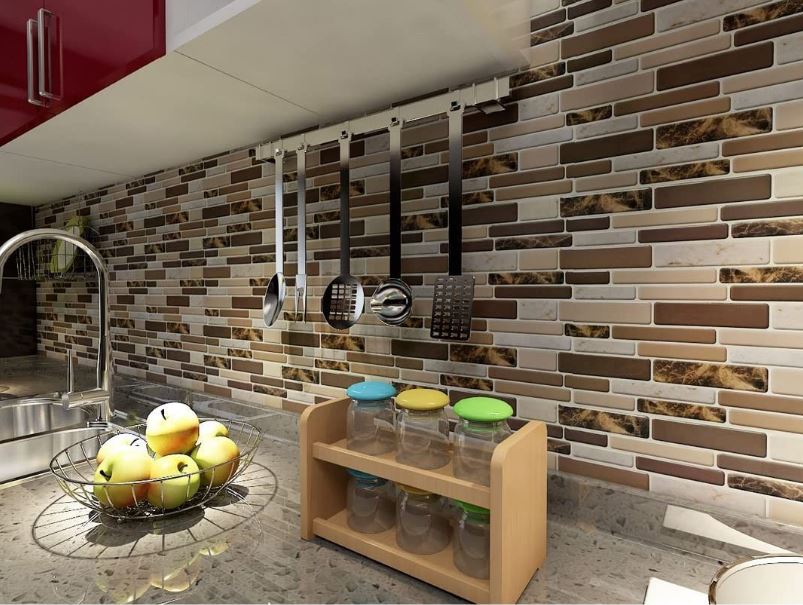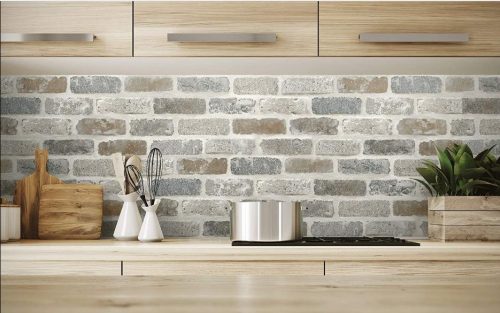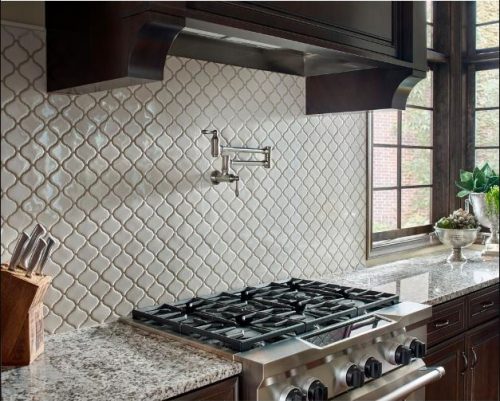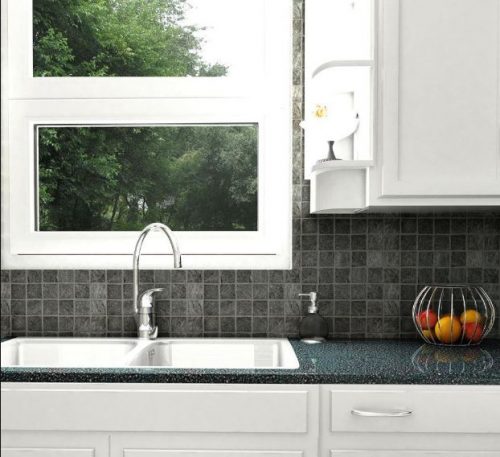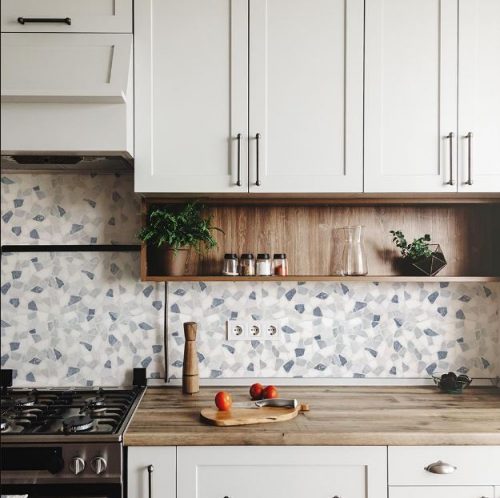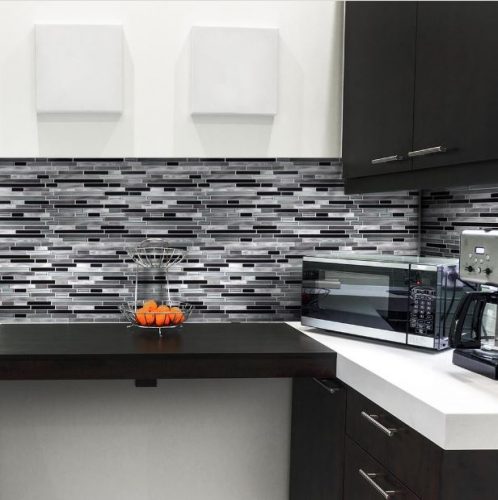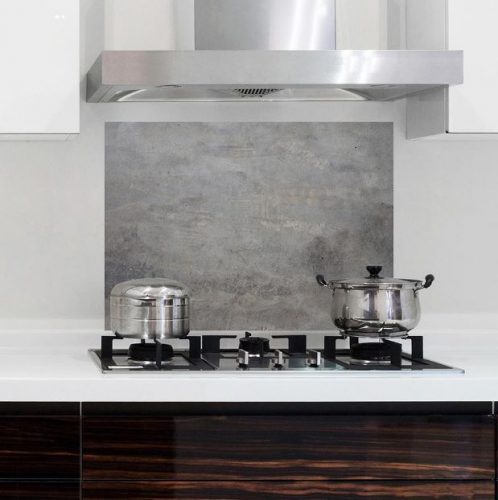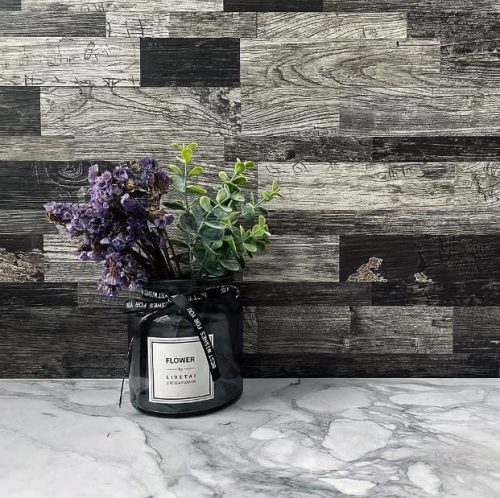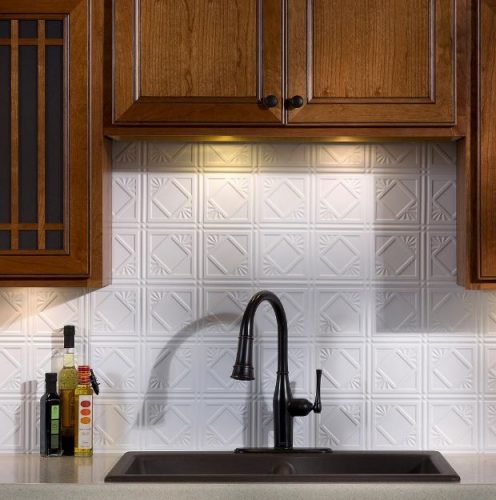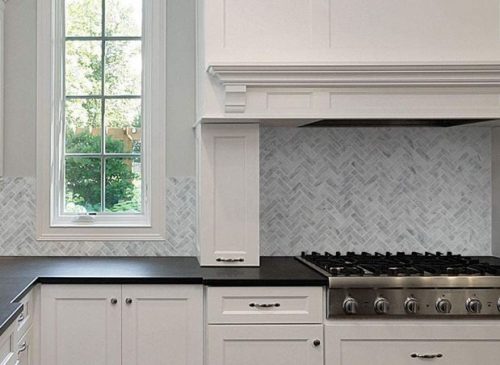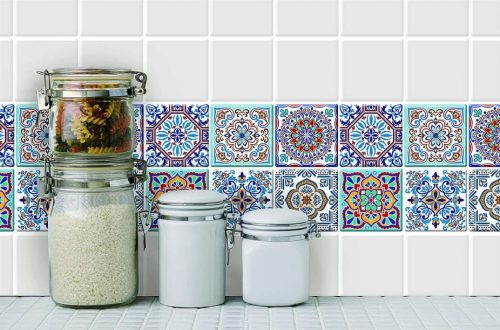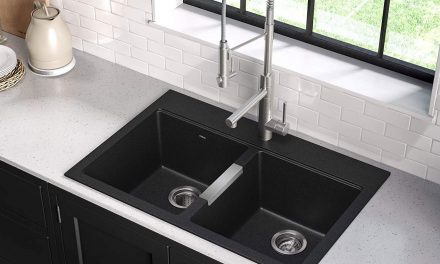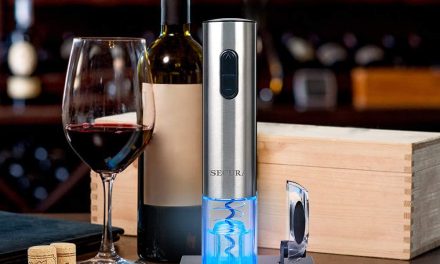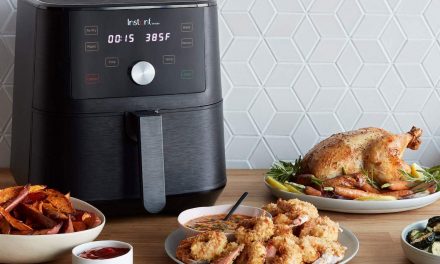The internet teems with kitchen backsplash ideas, but what is a backsplash and why is it so important? Basically, a kitchen backsplash is a layer of material designed to cover the wall between your counters and the bottoms of your cabinets. It’s called a backsplash because it was originally designed to protect your walls from the splashes and splatters that can happen during cooking.
Originally, backsplashes only extended a few inches above counters, but today’s backsplashes are often much larger, completely covering the area beneath the cabinets. Some even extend upward to the ceiling. Starting in the 1950s, kitchen backsplashes became increasingly popular, not just as functional pieces, but as fully decorative design elements.
Today, there seem to be as many backsplash ideas as there are kitchens. Different types abound, but most kitchen backsplashes are composed of either a solid slab of material or tiles of various materials and styles. These slabs and tiles fulfill the functional need of a backsplash while bringing your kitchen into a whole new decorative dimension.
In this article, we’ll talk about different types of kitchen backsplashes. We’ll look at materials, styles, shapes, patterns, and colors to find out which backsplash is best for you.
Types of backsplashes
One of the most important decisions you can make when choosing a kitchen backsplash is material. Not only does the material you choose affect the look of your backsplash, it also determines everything from cost and installation difficulty to durability and ease of maintenance and cleaning.
No matter what style you choose, a backsplash is an investment, both in time and money. Long-term appearance, then, is also an important factor to consider when choosing a backsplash. So let’s talk materials.
Brick backsplashes
By far, the most popular backsplash style is brick or another material styled to look like brick. As of 2019, it accounts for more than half of all backsplash patterns, so it’s safe to say it’s an “in” style.
Forms: Whole, solid bricks. Brick veneers (thinly-sliced bricks). “Brick-look” ceramic. Peel-and-stick wallpaper.
Appearance: Classic, old-world feel that pairs well with both traditional and contemporary styles. Brick is available in several colors to match your unique tastes, and you can even paint it to complement the rest of your kitchen.
Cost: $11-$20 per square foot, depending on form. Wallpapers, ceramic tiles, and brick veneers are relatively affordable and you’re less likely to need professional help when installing them. Real, solid bricks are more expensive to buy and installation may require help from a mason.
Installation: Whether you likely can DIY your brick backsplash or not depends on the type of brick backsplash you choose. If DIY installation is paramount, you’ll want to stick with brick-patterned wallpaper or peel-and-stick ceramic tiles. Or, if you feel skilled enough, brick veneer tiles.
Durability: Real brick and thin brick veneers are very heat resistant, while brick-patterned wallpaper may suffer from the heat and humidity a kitchen generates.
Maintenance: Thick grouting can wear away. Brick tends to be very porous, so regular sealing will be required for whole bricks and brick veneer. Its rough surface also makes it harder to clean. Ceramic tiles are lower maintenance, but won’t provide all the benefits and durability of real brick. Wallpaper, if it stains, is very hard to clean.
Long-term Appearance: With proper sealing and a little upkeep, a real brick backsplash will easily survive for decades. Even veneer can last a long time with some maintenance. Wallpaper is more likely to look dated sooner, but it’s also not too difficult to replace.
Porcelain and ceramic backsplashes
Porcelain and ceramic are some of the most popular materials for backsplashes, especially backsplash tiles. They’re a great all-around option for many people. They’re fairly easy to install and are available in a wide variety of colors, styles, and finishes.
Forms: Ceramic and porcelain tile. Peel-and-stick ceramic and porcelain tile. Ceramic and porcelain slabs.
Appearance: Available in the widest variety of styles, patterns, and colors. Can be styled to mock other, more expensive, materials. With a variety of finishes available, you can capture nearly every aesthetic with the right ceramic backsplash.
Cost: Available in a wide range of prices, $1-$30 per square foot, with slabs at the higher end (though installation costs of slabs may be high). Hand-painted, custom ceramic tiles can cost upwards of $100 per square foot.
Installation: Due to its fairly light weight, even real ceramic and porcelain tiles aren’t too hard as a DIY project. Peel-and-stick ceramic and porcelain tiles are easy to install and require no grout. Slabs are very heavy, and they tend to be somewhat fragile before placement, so they’ll likely require professional installation.
Durability: Reasonably durable. Heat resistant and unlikely to crack. Not very porous, so stains and water spots are less likely. Ceramic tile manufacturers rate the durability of their tiles under the industry-owned Porcelain Enamel Institute. (Yes, they rate their own product.) PEI scales range from 0 to 5, with 3 being the standard for heavily foot-trafficked residential use and 5 for commercial. For kitchen backsplashes, even a rating of 0 or 1 is acceptable. But if you’re concerned, check with the manufacturer of your tiles.
Maintenance: Don’t require sealing. Relatively easy to clean and maintain, depending on finish. Slabs and peel-and-stick don’t require grout, so they’re easier to keep clean.
Long-term Appearance: There are examples of ceramic tiles still in place after thousands of years. With some maintenance, your backsplash will maintain its look and function for many years to come.
Stone backsplashes
From classics like marble, granite, and travertine, to newer arrivals, like quartzite, natural stone is a great way to bring sophistication and class to your kitchen. Available in many styles and finishes, natural stone varies in durability and ease of maintenance, but all natural stone will increase the value of your home and, if properly cared for, will last for a very long time.
Forms: Stone tiles. Peel-and-stick stone tiles. Stone slab. “Stone-look” ceramic and glass tiles. Stone-look wallpaper. Engineered stone (see section below for more info).
Appearance: Varies widely depending on the type of stone, the finish, and even the specific stone sample. Can evoke many different light or dark, cool or warm moods, though all natural stone will increase the value of your home. If you intend to match your backsplash and countertop, one solid integrated slab is encouraged to ensure uniformity.
Cost: Natural stone tiles start at $10 per square foot, but prices vary widely depending on type of stone and quality. Peel-and-stick stone tiles are generally cheaper, but also vary. Stone slabs start at around $25 per square foot (not including installation costs) but can be much more expensive. Stone-look tiles and wallpaper are generally less expensive, but won’t have all the benefits of real stone.
Installation: Real stone tiles are heavy and difficult to install. Peel-and-stick tiles are easier, but their weight can still make installation difficult. Faux stone tiles and wallpaper are generally easy to install. Stone slabs are incredibly heavy and require professional installation, which can be especially pricey for stone.
Durability: Natural stone is generally very durable, though its scratch and gouge resistance depends on the type of stone and the finish. Some types of natural stone (like marble and travertine) can etch when exposed to acidic stains, while others may discolor from the use of certain abrasive cleaners. Sealants can help protect whatever real and natural stone you choose.
Maintenance: Natural stone is porous and requires regular sealing. Ease of cleaning depends most on the finish, with more polished finishes being easier to clean. Slab stone and peel-and-stick tiles don’t need to be grouted, so they’re a bit easier to keep clean.
Long-term Appearance: Stone backsplashes will look great for years to come if they’re taken care of. Depending on the finish and type of stone, these backsplashes can easily last for decades.
Metal backsplashes
Somewhat less common, but very popular in certain styles, metal backsplashes can be a real statement piece. From striking, antimicrobial copper to modern, clean-lined stainless steel to traditional tin tiling, metal backsplashes can really give you that “wow” factor.
Forms: Metal tiles. Metal veneer ceramic tiles. Metal peel-and-stick tiles. Metal panels. Copper sheet overlay. Metal-look glass tiles. ACM (aluminum composite material).
Appearance: There are several types of metal to choose from (and various finishes) that strongly affect the look of this kind of backsplash. Polished finishes have a shine like glass that brightens a space. Matte and textured finishes can give a more rustic feel, though metal backsplashes may look out of place in a more traditional kitchen.
Cost: Regardless of whether they’re tiles or panels, most metal backsplashes start at around $15 per square foot, though solid metal tiles and more expensive materials (like copper) will cost more. Metal-look glass tiles are more affordable, though they don’t have all the benefits of real metal.
Installation: ACM is easier to install, being lighter than solid metal. Tin tiles, peel-and-stick tiles, and metal veneer tiles are also fairly easy to install. Full metal tiles are heavier and harder to install. Metal panel backsplashes are easier to install than other kinds of slab backsplash, though copper overlays may be more complicated.
Durability: Heat resistant. Fairly durable and nonporous, so stains and water spots are less likely. Some metals, like copper, can react with acidic substances, like orange juice and tomato sauce, and may discolor. The relatively smooth surface of metal backsplashes is fairly easy to clean. Matte finishes hide scratches, and textured finishes (like brushed and hammered) can even hide minor gouges.
Maintenance: Stainless steel does not have to be sealed, though iron and copper backsplashes will oxidize and discolor if not sealed properly. Metal backsplashes are generally easy to clean, though textured surfaces can collect dust. Dents are possible with higher gauge (thinner) metal panels, depending on how they’re installed.
Long-term Appearance: Good, if well maintained, but scratches are very difficult (if not impossible) to fix. More polished finishes may lose their shine. Some metals (especially copper) are likely to develop a patina, even with proper sealing.
Engineered stone backsplashes
Engineered stone, also known as manufactured stone, is a great option for anyone who wants the look of natural stone, but not the price tag that comes with it. It’s made of pieces of natural stone, sometimes mixed with other materials like colored glass, shells, or mirror, and held together with a binder. Like natural stone, engineered stone will improve the value of your home and is available in a variety of styles and finishes to complement your kitchen.
Quartz is the gold standard of manufactured stone, and is a very common countertop and backsplash material. Quartz tends to be made of bits of quartz crystal, granite, and marble to create an especially durable material.
Forms: Engineered stone tiles. Peel-and-stick engineered stone tiles. Engineered stone slab.
Appearance: Available in more styles and colors than natural stone and tends to be more consistent in appearance. Almost any look can be manufactured, and all popular types of natural stone can be simulated.
Cost: $7-$12 per square foot for tile, on the lower end. Slab is more expensive, but still cheaper than natural stone.
Installation: Engineered stone is easier to install than natural stone, being lighter and more durable. But slabs are still incredibly heavy and will likely require a professional.
Durability: Harder than natural stone, so is less likely to chip and scratch. It’s not immune to staining, scratches, and gouging but can be refinished.
Maintenance: Nonporous, so it doesn’t need to be sealed (but can be), and water marks and stains are less likely. However, if engineered stone does stain, it can be difficult to clean without further damage. Engineered stone is generally easier to maintain than natural stone, and slab will be easier to clean than tile.
Long-term Appearance: Good, though manufactured stone can lose its color and shine after a few years—however unlikely—especially if exposed to consistent sunlight. A sealant may help.
Glass backsplashes
Glass backsplashes are a great alternative to ceramic that can bring a lot of light to a room. While glass can be fragile, glass backsplashes are relatively durable. Keep in mind, though, that some consider glass to be a particularly trendy material that may be on its way out of style.
Forms: Glass tiles. Peel-and-stick glass tiles. Glass sheets.
Appearance: Glass brings a sophisticated, clean-lined look to a kitchen. Its natural shine can bring light to a room, making it feel warmer. Glass tiles come in a wide variety of colors, styles, and patterns. Clear glass sheets can be installed to protect (but still display) other wall coverings, such as wallpaper.
Cost: $7-$30 per square foot for glass tiles, on the lower end. They tend to be more expensive than ceramic. Glass sheet backsplashes are around $45-$60 per square foot, with clear glass being the most affordable.
Installation: Glass tiles can be fragile in handling and do require precision, but can be installed by the homeowner if care is taken. Peel-and-stick glass tiles are easier to install and don’t require grout. Glass sheets are hard to install—professional installation is recommended—but they’re still easier than other kinds of slab backsplashes. Smaller panels may be DIY-able.
Durability: Highly stain resistant. Not as susceptible to scratching as some other materials but can chip, crack, or shatter in some circumstances. Okay for areas around stoves, but glass does not handle sudden temperature changes well.
Maintenance: Glass is nonporous and does not require sealing. Its smooth surface makes it very easy to clean, and minor scratches can be filled in with a glass polishing agent, though even fingerprints and minor smudges can mar its shine. Solid glass tiles can be harder to clean than glass sheets and peel-and-stick tiles because of the grouting.
Long-term Appearance: Scratches can build up, dulling glass tiles in the long run. However, colors are likely to stay as bright as they were when they were purchased.
Concrete backsplashes
Concrete is another option that fits perfectly into a variety of modern styles. Despite its sometimes cold and austere reputation, concrete can be made to fit warmer styles. Available in a variety of finishes, from polished to matte or textured, this material is a great option for many people.
Forms: Concrete tiles. Concrete slab. Faux concrete tiles.
Appearance: Concrete is highly customizable and available in a wide variety of colors and patterns. It’s a great modern option for industrial or contemporary styled kitchens.
Cost: $5-$30 per square foot for concrete tiles. Plastic faux concrete is cheaper. Slabs are usually priced at around $100 per square foot (including installation costs)
Installation: Concrete tiles are heavy and difficult to lay, and slab will require professional installation. Concrete tiles tend to be thicker than ceramic tiles, so space may be an issue depending on your kitchen layout. Peel-and-stick faux concrete tiles are easy to install.
Durability: Concrete is extremely durable and heat resistant. Faux concrete is less so, and isn’t recommended around stoves. Concrete can stain fairly easily if not cleaned promptly, even with regular maintenance.
Maintenance: Concrete is porous and requires regular sealing. Depending on style, minor scratches may be hard to see. Concrete is relatively easy to clean (if cleaned quickly) depending on finish.
Long-term Appearance: Concrete’s durability shines here, and scratches and minor gouges can be removed from either tiles or slab through refinishing. Concrete’s appearance may change over time, though higher quality concrete is likely to maintain its color. Faux concrete is unlikely to last nearly as long as the real thing.
Wood backsplashes
From rustic and homey to modern and contemporary, a wood backsplash can evoke many different moods. Wood backsplashes are especially suitable for minimalist or cottage style kitchens, and painted shiplap and beadboard are especially “in” right now.
Forms: Peel and stick wood tile. Wood plank and shiplap. Beadboard (a type of vertical wood paneling). Butcher’s block slab. Wood-look ceramic tile and wallpaper.
Appearance: Generally warm, in looks, though appearance varies widely. From light woods (and stains) that brighten a kitchen to darker woods (and stains) that can bring a feeling of sophistication to painted woods for a sleek, modern style, a wood backsplash can be whatever you want it to be.
Cost: $3-$12 per square foot on average for peel-and-stick tiles and planks, though harder-to-find and specialty reclaimed woods will be pricier and recycled wood boards are likely to be cheaper. In this instance, wood-look tiles may actually be more expensive than some actual wood options. Butcher’s blocks start at $40 per square foot.
Installation: Relatively simple for peel-and-stick tiles, planks, beadboard, and wallpaper. Butcher’s blocks are more likely to require professional installation, but they’re generally easier to install than stone or ceramic slabs.
Durability: Not especially heat resistant, so this kind of backsplash is not advisable near stoves. Finishes can scratch and wear and may show worse on a darker wood (or a darker stain). Reclaimed wood planks will hide wear best, since these are already worn. Wood-look tiles are likely to be more durable, and wallpaper less.
Maintenance: Requires careful sealing to avoid water damage, stains, and warping. Fairly easy to keep clean if properly maintained, though woods with an aggressive grain will collect dust and require additional scrubbing. Wood generally isn’t grouted, so that won’t be a cleaning concern. Wood-look tiles are generally easier to maintain. Wallpaper is unlikely to last long unless covered by glass.
Long-term Appearance: Is likely to change in appearance over time and is more likely than other styles to warp, especially in humid environments. Wood is a good candidate for refinishing, however. Wood-look tiles will be more long lasting. Wallpaper is likely to peel and tear, long term.
Plastic backsplashes
By far the most affordable option, plastic backsplashes come in a number of varieties and a wide range of colors. They may not be the highest quality option on the market, but they can still protect your walls from stains.
Forms: Vinyl peel-and-stick tiles, panels, and slab. Vinyl floor covering repurposed as wall covering. Thermoplastic slab. Laminate slab. Tileboard.
Appearance: Available in many colors and patterns. Are often designed to mimic more expensive materials. Can look a lot like the real thing, especially at slightly higher price points. But most plastic backsplashes look visibly cheap upon close inspection.
Cost: $1-$10 per square foot for thinner vinyl, $30-$40 at the high end for thicker vinyl slab. Thermoplastic slab is $7-$15 per square foot while laminate is usually less than $5. Tileboard is generally less than $1 per square foot.
Installation: Very easy. Plastic is among the lighter options available for backsplashes, and most plastic backsplash tiles are peel-and-stick.
Durability: Most are not heat resistant, so they won’t work around stoves. Peel-and-stick vinyl and thermoplastic can sometimes be installed near electric stoves, but take care near open flames. May discolor without proper maintenance and generally not waterproof. Tileboard (made of compressed wood fibers coated in melamine plastic) is especially susceptible to water damage.
Maintenance: Scratches aren’t generally hard to buff out, though cracks and gouges can’t always be fixed. Refinishing is possible, but not especially cost effective. For most plastic backsplashes, replace, not repair is the watchword of the day.
Long-term Appearance: Adhesive can wear over time, and the backsplash can peel. Some plastics, like vinyl, can yellow, especially if not properly maintained. Many plastic backsplashes can swell with high humidity, and mold may become a problem.
Backsplash shapes, patterns, and colors
Once you’ve chosen the material for your backsplash, there’s another important question—what about style? Whether you choose tile, slab, or another style entirely, there are a number of color and pattern options available. And for tile, whether ceramic or glass, stone or concrete, tile shape, pattern, and color can completely change how your kitchen looks.
Shapes
Backsplash tiles are available in a wide variety of shapes, and they can be cut into even more. The most popular shapes for backsplash tiles are square, rectangular, hexagon, and round. Square tiles are the easiest to install, but have few patterns available. Rectangular tiles can be harder, depending on pattern, but there are many pattern options available. Hexagonal and round tiles can bring a different, but still geometric, look to your kitchen. Other basic geometric shape tiles are available, like triangle, diamond, and oval.
Specialty tiles are another common (and popular) category. This is a broad category that includes a wide variety of shapes. The most popular specialty tiles are arabesque, basketweave, chevron, and fish scale. These tile shapes can usually only be installed one way, so, basically, the shape is the pattern.
Some styles of backsplash can come as planks that can be installed horizontally or vertically. Horizontal is generally easier to install and can make your kitchen seem larger. This style is best for rustic, classic looks. Vertical planks can make your ceilings seem higher and are preferred in many contemporary styles.
If you’ve chosen a simpler shape (or a slab) you’ll also need to choose a pattern.
Patterns
The most popular tile pattern is brick. This style uses rectangular tiles to simulate the repeating, alternating pattern of a brick wall. The consistently popular subway style is very similar to this, though the size and proportions of the tiles are usually different. Herringbone is another popular style you can create with rectangular tiles. In this style, tiles are set at 90° from each other to achieve a cascading look.
A grid pattern is just what it sounds like—square tiles are set with their corners touching, creating a grid effect on your wall. Similar but more complicated effects can be achieved with other tessellating shapes, like diamonds (lattice pattern) and hexagons (honeycomb pattern).
A patterned look, also sometimes called mosaic tile, takes the designing and laying of a complicated pattern out of your hands. These tile sets consist of a variety of individual tiles bound together into a preset pattern. A patterned look means you’ll have fewer options than designing a pattern yourself, but they’re much easier to install. They’re also a great option if you like the look of multiple materials and finishes, but don’t want to have to make sure all these different tiles fit together.
Once you’ve decided the shape of your tiles and how they’ll fit on your wall, the next step is the color.
Colors
Backsplashes are available in a wide variety of colors. For materials like ceramic, glass, concrete, plastic, and wallpaper, the sky’s the limit on color and design. But even for materials with specific looks, like metal, wood, brick, and natural and engineered stone, you’ve still got options.
For many kinds of slab backsplash, you’ve got even more options. It’s very easy to paint glass, concrete, plastic, and wood to look however you want. And, best of all, if you get tired of your color or design, you can paint over it. Even tiles can be repainted, as long as you have a grout pen, some patience, and a little know how.
This is just the beginning for backsplash shapes, patterns, and colors. Your kitchen backsplash is a great place to show off some creativity, and a good backsplash will increase the value of your home.
Backsplash DIY
Planning to DIY? Here’s our advice.
- Strongly consider ceramic tiles. These are by far the best combination of ease-of-installation, ease-of-maintenance, price, and appearance. If you’re especially interested in increasing the value of your home, consider engineered stone for its higher durability and easier install than natural stone.
- Pick an easy to install tile shape, like square or round, or skip the complicated installation entirely and choose a patterned look.
- For best resell value, consider neutral, popular colors, like white and gray, and subway tiles.
- Make sure your backsplash coordinates well with the rest of your kitchen.

